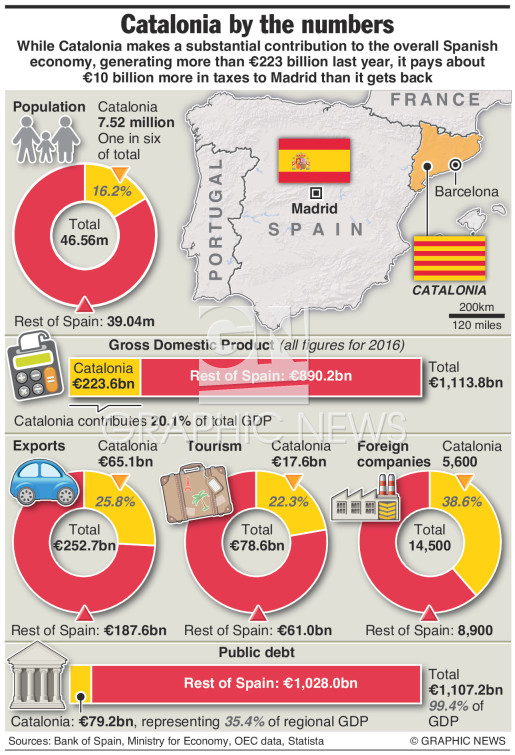The origins of the Catalan Language
Catalan is a Romance language spoken in Spain and Andorra. It is the official language in Andorra and an official language in three communities in Spain (communities here being a political entity like an American county or state). It has about 4 million native speakers. It is also spoken in some parts of Italy and France. Standard Catalan is based on the Eastern Catalan variety. However, depending on the speech community, there may be dialectal differences. Research into the language and its preservation are done by the Institute for Catalan Studies and the Valencian Language Academy.
The name comes from Catalonia, a medieval principality in Spain. Catalonia is also now the name of an autonomous community in Spain. In addition, a region with the name of North Catalonia in France also exists, and the Catalan language also remains used to a large extent in this region.
Similar to all Romance languages, it evolved from Vulgar Latin, spoken Latin during the Middle Ages. Specifically, it evolved from the Vulgar Latin spoken around the area of the eastern Pyrenees. As such, it shares many characteristics with other Romance languages such as Spanish, French, Italian, etc. Despite the majority of Catalan speakers being located on the Iberian Peninsula, Catalan has more similarities with French and French dialects, such as Occitan, than the other Iberian Romance languages such as Spanish and Portuguese.
Catalan, like many other languages in the region, has borrowed many loanwords from both Greek and Latin early on in its history. As a Romance language, it exhibits similar grammar to its relatives. The word order is subject-verb-object, and verbs inflect for person and tense. Depending on the variety of Catalan being spoken, the conjugations may differ. Also depending on the dialect, word choice may differ as well, even though overall there is much uniformity among the different speaking Catalan communities.
Catalan is written using the Latin script. It uses the 26 basic letters of the Latin alphabet, but there are additional forms with accent marks on them to signify different sounds. However, these do not constitute different letters. Like many other languages that use the Latin script, it is written from left-to-right and uses many of the same punctuation marks as the other Romance languages.

Catalan’s history can be traced back to its derivation from Vulgar Latin. Vulgar Latin was spoken Latin during the Early Middle Ages that eventually split into different languages. The dialect of Vulgar Latin was spoken in the Pyrenees and Catalonian regions. By the 800s, the Vulgar Latin in these regions had become distinct enough to be known as Catalan. With some political changes such as Catalan counts gaining land and the County of Barcelona separating from the Carolingian Empire, the language was further spread and solidified in terms of a group identity.
Documents that feature Catalan writing began to appear at the end of the 11th century. In the Late Middle Ages, more literary appeared especially ones that provided evidence of Catalan’s prestige. Works by the polymath Ramon Llull, important poetry, and the Four Great Chronicles were all written using the language, and this helped in its spread and diffusion as a language of prestige.
With the formation of separate French and Spain identities, and the Catalan speaking communities existing in both territories, the linguistic situation became complicated. Starting in the 1700s in France, Louis XIV issued a royal decree prohibiting Catalan’s use in Catalonian regions in France. Even after the French Revolution, many policies aiming to strengthen a French republic were put into place, therefore marginalizing non-standard languages, including Catalan, but other French dialects as well. Such policies have remained mostly until the present day, even though in 2007, there was official recognition by the General Council of the Pyréneés-Orientales of Catalan as one of its official languages. This new status helped boost Catalan in the Northern Catalonian area in France.
While at the beginning of the 18th century, language policies regarding Catalan in Spain were also discriminatory against the language, the situation is a bit different than in France. Initially, the use of Catalan in public spheres such as government and education was banned in the Kingdom of Spain. During the Franco regime (1935-1975), this suppression was continued and there was much propaganda promoting Spanish in place of Catalan in regions where Catalan was widely used. However, during the later period of Francoist Spain, policies started to change. First, certain folk traditions relating to Catalan were tolerated. In the 1950s, Catalan was also permitted in the theatre. This paved the way for a cultural revitalization relating to the language.
With the construction of a constitutional monarchy in 1975, Catalan use spread as policies were much more friendly towards its existence. In fact, the policies even supported Catalan usage in the public sphere as a way to promote Spain’s diverse cultures. Due to such changes, the Catalan language is now very prominent in public including politics, media, education, and more.
Presently, the presence of Catalan can be seen in the Catalan speaking regions. It is mostly associated with Spain in the region of Catalonia. In this area, the language is on prominent display with signs being in both Spanish and in Catalan and the dialect being heard every day in large tourist cities like Barcelona. In addition to being spoken in Spain, it is also used in the Pyréneés-Orientales department in France, in Andorra, and in the Alghero region of Italy. With speech communities of Catalan existing in many areas, separate Catalan dialects have also developed. With still a sizable speaking community, a prestige position in history, and a key to understanding a part of the European culture in the region, Catalan remains an important language.
VEQTA can provide you with a perfect Catalan translator for your Catalan translation, English to Catalan translation and Catalan to english translation for the your targeted locale. Our translations to Catalan are created with your target audience in mind to meet your expectations.
If you need to translate Catalan – Get in touch today!
A dedicated team of Catalan translators who combines Experience, Specialized Subject Matter Expertise with Translation Practices to deliver quality second to none.
Catalan Subject Expertise
Catalan Translators
Catalan Editors
Catalan Copywriters
Catalan Reviewers
Catalan Voice dubbing
Catalan Subtitling
Catalan Transcription


